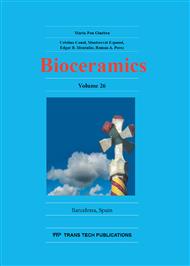p.341
p.345
p.351
p.357
p.363
p.367
p.373
p.379
p.384
Characterization of Human Osteoclasts on Different Bioceramics
Abstract:
@font-face { font-family: "MS 明朝"; }@font-face { font-family: "Cambria Math"; }@font-face { font-family: "@MS 明朝"; }p.MsoNormal, li.MsoNormal, div.MsoNormal { margin: 0mm 0mm 0.0001pt; font-size: 10pt; font-family: "Times New Roman"; }.MsoChpDefault { font-size: 10pt; }div.WordSection1 { page: WordSection1; } Bioresorbable materials may be advantageous for use in bone regeneration applications because they do not leave residues of foreign material, improving the long-term success of implant restoration. The purpose of this study was to investigate the osteoclastogenesis and bioresorption of synthesized calcium phosphate ceramic materials for orthopaedic and dental biomaterial applications. Differentiation into mature human osteoclasts on carbonated hydroxyapatite (CA) was significantly enhanced compared to hydroxyapatite (HA). Osteoclasts derived from human peripheral mononuclear blood cells adhered and differentiated into giant multinuclear TRAP- positive cells on every type of synthesized sample based on the histological analysis. Morphological observations using fluorescence and quantitative analysis revealed that the actin rings of osteoclasts on CA were thick and small in diameter, similar to the rings found on bone slices. Scanning electron microscopic images and quantitative analysis indicated that the resorption pits on CA were significantly deeper than those on HA due to the enhanced tight sealing ability between osteoclasts and their substrate.
Info:
Periodical:
Pages:
363-366
Citation:
Online since:
November 2014
Keywords:
Price:
Сopyright:
© 2015 Trans Tech Publications Ltd. All Rights Reserved
Share:
Citation:


